Simple & Smooth Homemade Hummus Recipe: Whip It Up Today
Creamy, dreamy homemade hummus can revolutionize your snack game in unexpected ways.
Mediterranean kitchens have long celebrated this versatile dip’s incredible potential.
Chickpeas blend beautifully with tahini, creating a smooth and irresistible spread.
Garlic and olive oil add depth to every spoonful.
Rich in protein and nutrients, this recipe brings restaurant-quality results right to your kitchen counter.
Minimal ingredients and simple techniques make you a hummus hero in minutes.
Prepare to impress your taste buds with this classic Middle Eastern delight.
Variations for Homemade Hummus
Best Pairings for Homemade Hummus
Pair homemade hummus with warm, fluffy pita bread or crisp, colorful vegetable sticks for a satisfying crunch and texture contrast.
Arrange hummus as a centerpiece surrounded by olives, feta cheese, dolmas, and grilled eggplant to create an authentic Mediterranean dining experience.
Enjoy light, crisp white wines like Sauvignon Blanc or refreshing herbal iced tea that complement the creamy, tangy hummus flavor profile.
Sprinkle fresh chopped parsley, mint, or za’atar spice blend on top to elevate the hummus’s earthy chickpea base and add vibrant aromatic notes.
How to Store Homemade Hummus Properly
FAQs
The main ingredients are chickpeas, tahini, garlic, lemon juice, olive oil, cumin, and salt. These components create the classic creamy and flavorful dip.
Yes, hummus is packed with protein, fiber, and healthy fats. It’s a nutritious spread made from plant-based ingredients that can support heart health and provide sustained energy.
You can use a blender or mash chickpeas manually with a potato masher, but a food processor gives the smoothest texture. Hand-mashing might result in a chunkier consistency.
Why Homemade Hummus Beats Store-Bought
Ingredients for Homemade Hummus
Main Ingredients:Seasonings and Spices:Liquid and Finishing Ingredients:How to Make Homemade Hummus Easily
Step 1: Prep Chickpea Base
Toss chickpeas, tahini, garlic, lemon juice, cumin, and salt into a food processor. Pulse the mixture until it creates a chunky, textured consistency that hints at the deliciousness to come.
Step 2: Whip Into Creamy Perfection
Slowly stream in olive oil and water while continuously running the food processor. Watch as the hummus transforms from a rough mixture into a silky, smooth spread that will make your taste buds dance.
Step 3: Fine-Tune the Flavor
Take a quick taste and adjust the seasoning. Want it zingier?
Add more lemon. Craving depth?
Sprinkle in extra cumin. Trust your palate and make this hummus uniquely yours.
Step 4: Plate With Pizzazz
Transfer the velvety hummus to a beautiful serving bowl. Drizzle a swirl of olive oil across the top and dust with vibrant paprika or sprinkle fresh herbs like parsley or cilantro for a pop of color and flavor.
Step 5: Serve and Enjoy
Surround your hummus with crispy pita chips, crunchy carrot sticks, or whatever dipping companions you love. Dive in and savor every creamy, flavor-packed bite of your homemade creation.
Tips for Creamy Homemade Hummus
Print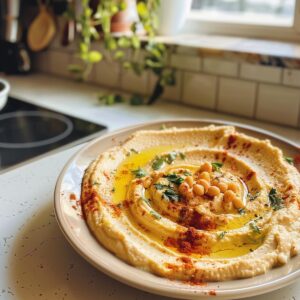
Hummus Recipe
- Total Time: 10 minutes
- Yield: 4 1x
Description
Mediterranean comfort finds its soul in Classic Hummus, a creamy chickpea spread that whispers delicious stories of Middle Eastern kitchens. Rich, smooth, and perfectly balanced, this simple dip connects culinary traditions with each silky spoonful you’ll savor.
Ingredients
Main Ingredients:
- 1 can (15 ounces/425 grams) organic chickpeas, drained and rinsed
- 1/4 cup (60 milliliters) tahini
- 2 garlic cloves (raw or roasted)
Liquid Ingredients:
- 2 tablespoons (30 milliliters) fresh lemon juice
- 2 tablespoons (30 milliliters) extra virgin olive oil (plus more for drizzling)
- 4 tablespoons (60 milliliters) water
Seasonings:
- 1/2 teaspoon ground cumin
- 1/2 teaspoon salt (adjust to taste)
Instructions
- Assemble fresh chickpeas, tahini, garlic, lemon juice, cumin, salt, olive oil, and water on a clean kitchen workspace.
- Place chickpeas and garlic into a food processor, creating an initial rough texture by pulsing for 30 seconds.
- Add tahini, lemon juice, cumin, and salt to the processor, blending until ingredients are partially integrated.
- While processor is running, slowly stream olive oil and water into mixture, continuing to blend for 2-3 minutes until achieving a silky, uniform consistency.
- Pause processing and taste the hummus, carefully adjusting seasonings if the flavor profile requires enhancement.
- Carefully transfer the creamy hummus into a decorative serving bowl, using a spatula to ensure complete transfer.
- Enhance visual appeal by drizzling additional extra virgin olive oil across the surface and sprinkling paprika or chopped fresh herbs like parsley or cilantro.
- Accompany the hummus with crisp pita chips, sliced cucumber, carrot sticks, or bell pepper strips for a vibrant and inviting presentation.
Notes
- Drain and rinse chickpeas thoroughly to reduce sodium and improve texture, ensuring a smoother, lighter hummus.
- For ultra-creamy consistency, remove chickpea skins by gently rubbing them between paper towels before blending.
- Experiment with additional flavors like roasted red peppers, sun-dried tomatoes, or jalapeños to create unique variations of classic hummus.
- Store homemade hummus in an airtight container in the refrigerator for up to 5 days, adding a thin layer of olive oil on top to prevent drying out.
- Prep Time: 10 minutes
- Cook Time: 0 minutes
- Category: Appetizer, Snacks
- Method: Blending
- Cuisine: Middle Eastern
Nutrition
- Serving Size: 4
- Calories: 180 kcal
- Sugar: 1 g
- Sodium: 290 mg
- Fat: 11 g
- Saturated Fat: 1.5 g
- Unsaturated Fat: 9 g
- Trans Fat: 0 g
- Carbohydrates: 15 g
- Fiber: 4 g
- Protein: 6 g
- Cholesterol: 0 mg

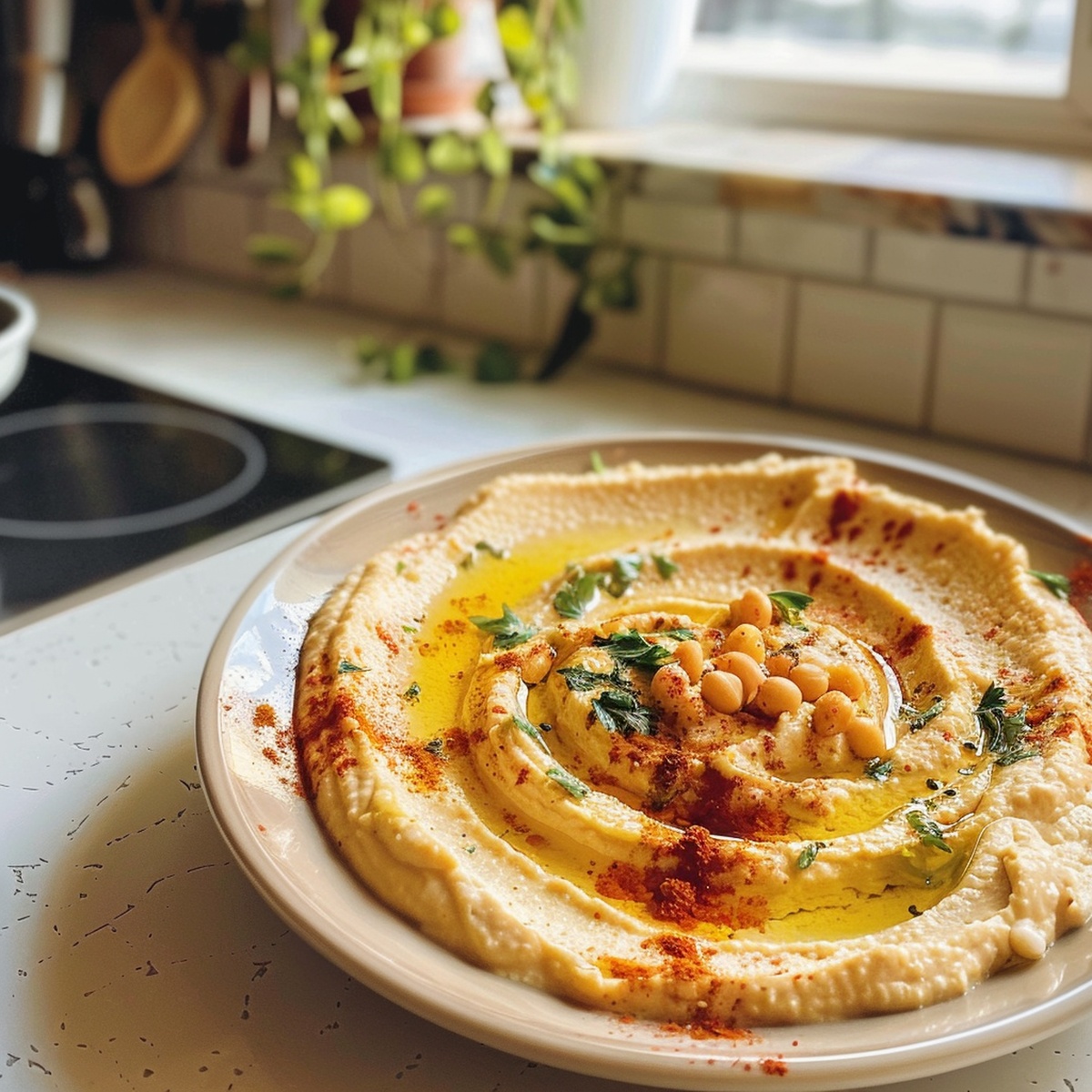
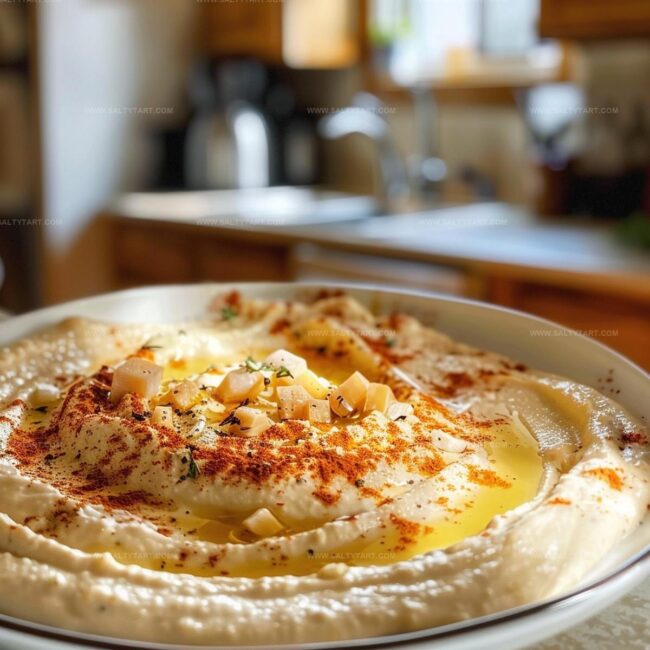
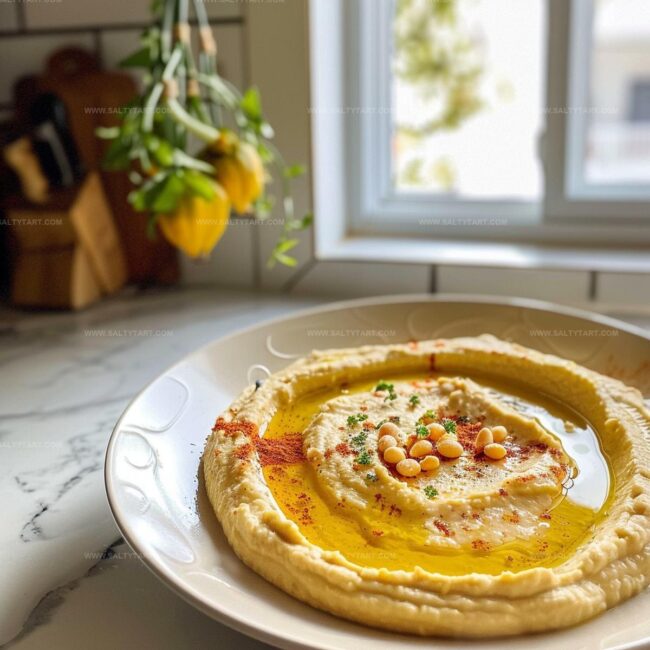
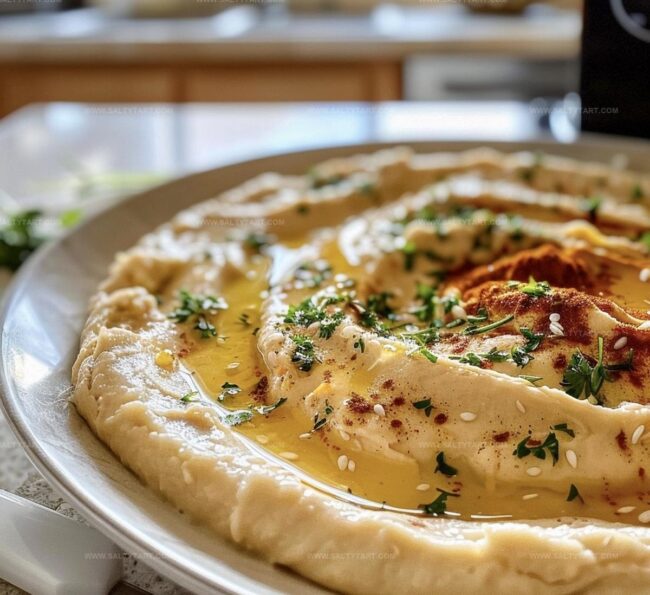
Mike Reynolds
Founder & Recipe Developer
Expertise
Farm-to-table cuisine, Seasonal recipe development, Sustainable cooking techniques, Food photography
Education
Asheville-Buncombe Technical Community College (A-B Tech)
Associate Degree in Culinary Arts
Mike studied culinary arts with a strong focus on farm-to-table principles and sustainable cooking. His training emphasized the importance of fresh, local ingredients and environmentally responsible practices in the kitchen.
Mike’s food journey began deep in the Blue Ridge Mountains, where weekends at farmers’ markets and home-cooked meals sparked a lifelong obsession with simple, seasonal eating.
After earning his Associate Degree in Culinary Arts from Asheville-Buncombe Technical Community College, he set out to bring farm-to-table cooking into everyday kitchens, without the fuss.
Mike’s philosophy is all about keeping it fresh, unfussy, and full of heart. When he’s not crafting new single-serving recipes, he’s hiking mountain trails, chatting with local farmers, or experimenting with wild ingredients in his backyard kitchen.